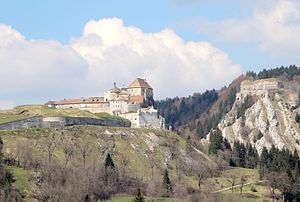Château de Joux
| Château de Joux | ||
|---|---|---|
|
Château de Joux as seen from La Cluse-et-Mijoux |
||
| Castle type : | Hilltop castle | |
| Conservation status: | Received or received substantial parts | |
| Place: | Pontarlier | |
| Geographical location | 46 ° 52 '22 " N , 6 ° 22' 25" E | |
|
|
||
The Château de Joux (or Fort de Joux ) is a fortified castle near Pontarlier , Franche-Comté , France in the French Jura .
location
The castle is located in a strategically important place above the small town of La Cluse-et-Mijoux . The trade route Dijon-Lausanne used to cross the Jura mountains here. The road runs through a rocky cliff and could therefore be easily controlled from the castle.
history
The castle was first mentioned in a document in 1034. The ruling family of the Lords of Joux died out in 1410. In 1454 Philip the Good bought the fortress. In 1530 it came into the possession of Charles V. It was not until 1674 that the province became French again.
After his arrest in 1774, Gabriel de Riqueti, comte de Mirabeau, was transferred from the Château d'If prison off the coast of Marseille to the Château de Joux in 1775. He was able to flee to Switzerland because of the relaxation of the prison regime.
On April 7, 1803, the imprisoned François-Dominique Toussaint L'Ouverture , Haitian national hero of African origin and one of the first leaders of the Latin American independence movement and the liberation of black slaves, died of the conditions of imprisonment after eight months in his cell in the Château de Joux.
During the Fourth Coalition War between Prussia and France, Heinrich von Kleist was imprisoned for four weeks in the Château de Joux as an alleged Prussian spy. Kleist's comrade Carl von Gauvain was placed in the same cell in which Toussaint L'Ouverture died.
In the wars of 1814 and 1871, the castle had to defend itself against attacks. In 1940 the history of the castle as a military fortress ended after the German Wehrmacht had successfully resisted for eight days.
Structure and sights
The core of the castle dates back to the 11th century and today consists of 5 successive fortress walls. It was expanded in the following centuries, most recently in 1879 by Captain Joffre .
Attractions:
- Horseshoe Tower (1486)
- Grammont yard
- Arms Museum
- Mirabeau's cell
- Dungeon of Berthe von Joux
- Cell by Toussaint L'Ouverture .
- Castle fountain (built in 1690 by Vauban ) with a diameter of 3.70 m and a depth of 120 m.
Current
The castle has been restored since 2000 with financial support from the French state. The fortress can now be visited on hourly tours and houses a small museum with military equipment of the French army from the 18th and 19th centuries.
Web links
- Official website (French)
Individual evidence
- ↑ Walther L. Bernecker : Little History of Haiti (= Edition Suhrkamp 1994 = NF 994). Suhrkamp, Frankfurt am Main 1994, ISBN 3-518-11994-X , p. 44.
- ^ Letter from Kleist ( Memento of the original dated September 3, 2011 in the Internet Archive ) Info: The archive link was inserted automatically and not yet checked. Please check the original and archive link according to the instructions and then remove this notice. to Christoph Martin Wieland , March 10, 1807



